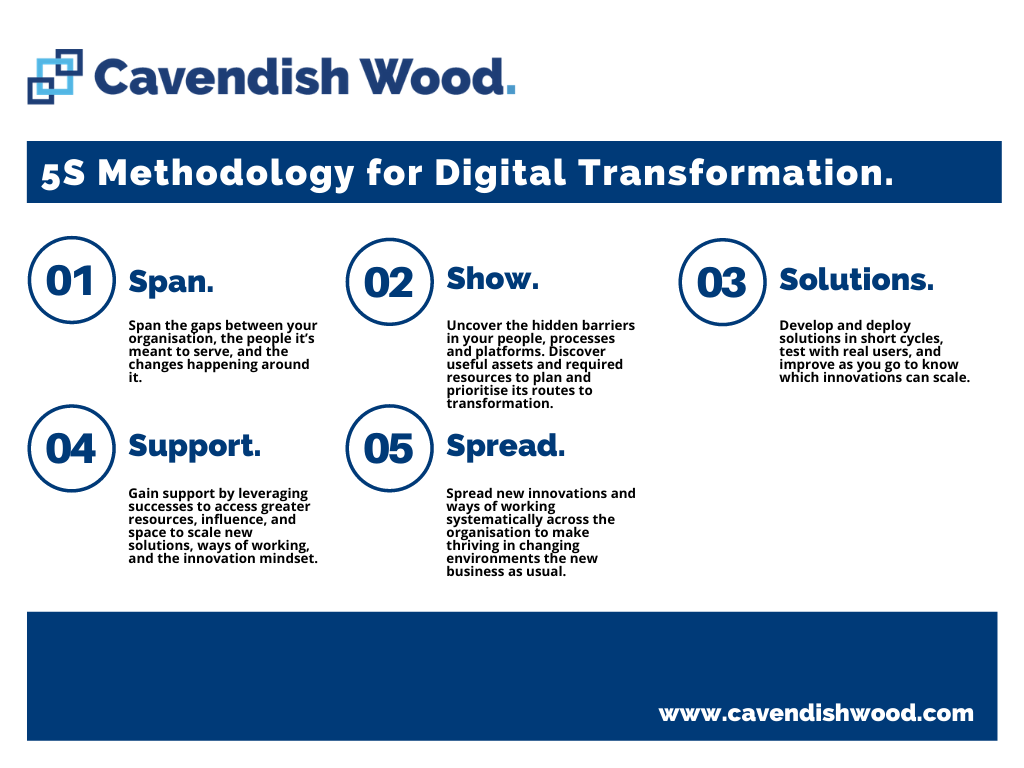
In my last blog about local government digital transformation, I discussed the three key objectives to which local authorities must drive their digital programmes. Additionally, I covered some of the issues and challenges that are common across all levels of local government and the key reasons that transformation can often seem like an impossible destination for your organisation.
SKIP TO ALL STAGE EXPLANATIONS:
I also introduced the "5S Methodology for Digital Transformation" developed by Cavendish Wood out of the last five years, working hand in hand with public and private sector organisations to deliver meaningful and lasting transformation.
In this second part of the series Local Government Digital Transformation – A Blueprint for Success, I'll introduce phase two of the methodology: "Show".
In phase one, "Span", you built meaningful connections from our organisations' interior to the outside world. Undertaking dialogue with customers, peers and partners to gain tangible information and data will enable you to understand precisely what needs to change and how quickly.
You used that intelligence to define a "Shared Vision for Transformation". A succinct set of statements that outlined where the organisation is today, a vision for the future and why it needs to change.
You also appointed a leadership group responsible for driving transformation forwards, ensuring resource and budget is available to set out on our digital journey.
Show.
In phase two, "Show", you will flush out all of the barriers to transformation that hide in your organisation. You will also find critical assets and resources and start to plan and prioritise the initial projects to tackle as you set out to achieve your vision for digital transformation.
The key objectives of "Show" are:
- Show the hidden barriers in your people, platforms and processes that pose a risk to transformation.
- Show assets that enable you to do more, quicker and with less.
- Identify business outcomes that digital change projects will deliver to support the organisation to achieve its vision.
- Show any skill gaps and start to fill them.
- Show any resource gaps and begin to fill them.
- Create and deploy a benefits management capability to capture the service, financial and efficiency benefits that transformation will achieve.
- Create and deploy the first cross-functional teams to start delivering solutions.
How to "Show."
This stage of transformation primarily aims to show the barriers that already exist within your organisation. Barriers that, if left unchecked, would seriously hamper your efforts and risk time, money and energy being wasted. This is the very definition of transformation failure when a critical barrier stops transformation dead in its tracks.
The good news is that there is a structured and thorough approach to finding barriers to digital transformation because there is a commonality across every sector, including both private and public sectors.
By adopting the approach outlined in this article, you will be able to:
- Show the barriers in your organisation
- Combine them with the gaps discovered during the "Span" phase of transformation
- Form the initial projects that should be addressed by the cross-functional teams you will deploy at the end of this phase. These are called "Pathways to Transformation" and will become critical to your organisation's digital success.
What are barriers to transformation?
It's worth noting that barriers to digital transformation aren't the same as your usual run of the mill business problems. We are not talking about sector or organisation specific barriers to things like growth, product adoption or profitability.
There are very particular attributes that every local government organisation must have to deliver relevant, modernised services in the digital age of rapid change and technology advancements. This means that barriers to transformation are also the barriers that hinder or stop a local authority from reacting to and keeping pace with external digital change.
Unless these barriers are found and mitigated, your digital transformation cannot succeed.
As I've written about many times and discussed with clients many times, digital transformation isn't about implementing new technology. It's a complete transformation of the organisation, and the first step is to find the barriers that will stop you from doing that.
This may sound like a slightly daunting task. However, because of the universal commonality I mentioned earlier, finding them is made more manageable.
For this exercise, it's helpful to break your organisation down into three distinct areas, the areas where most, if not all, barriers to transformation can be found. :
- People: Everything relating to your staff - roles and responsibilities, culture, management style.
- Processes: Every aspect of the operation of your organisation, including internal and external transactions, rules, ways of working, workflows.
- Platforms: Everything related to IT and technology.
Approaching this phase using this structured breakdown will significantly increase your chances of successfully flushing out the barriers that could derail your digital transformation.
People barriers.
This is where I will repeat myself several times. And I make no apologies for it because this is the key to your transformation. Make no mistake, your people are your biggest barrier to transformation. However good you believe them to be, however open to change they seem, they are your most significant risk. It is critical that we all understand this, however uncomfortable it feels.

There are generally three ways in which people become barriers to digital transformation:
#1: False logic.
The first and all too common way that people become barriers is that they are operating with false logic. An example of this is:
"This is the way we have always done it, so there must be a good reason".
Thankfully this barrier is relatively easy to overcome. Simply find the source of the logic, and show them that it doesn't add up. Once people see that they are wasting time, resource and energy, it's usually quite easy to get them to change.
#2: Poor accountability.
The second way for people to be barriers to transformation is that they have poor accountability. The kind of accountability I am referring to is direct accountability for their contribution to the organisation's reason to exist.
What we're discussing here is the accountability between the actions of staff and the success of the company. This is critical for a digitally mature organisation.
For any organisation to be efficient at serving its core purpose, all effort and work should be measured against whether or not it contributes to that purpose. This is especially true for organisations that need to digitally transform.
Otherwise, people will simply carry on doing the same today as they did yesterday. Implementation of new platforms are essentially pointless investments. This is a trait of inward-facing organisations. When you're not facing outwards, not putting yourself in your customer's shoes and not looking beyond your own area of responsibility, it doesn't matter what technology you have. Nothing will change.
Poor accountability also removes any sense of urgency or time-based pressure. This seems to be especially prevalent in local government organisations that have a captive market. In turn, this is exacerbated by inwardly focused management that creates their own methods of performance management that do not contribute towards the organisation's core purposes.
Support functions such as IT and HR need to be just as accountable for the productivity they enable.
IT KPI's around simply keeping things working means there is no incentive to find innovative ways to facilitate better organisational-wide performance or enable better connectivity and collaboration between systems and external partners.
It is critical to develop accountability that links directly to the transformation vision you set in phase one: "Span". I'll talk in more detail about how to create this accountability later in this article.
#3: Missing a mindset of innovation.
The most common reason for transformation failure is one of mindset—specifically, the organisational mindset required for digital transformation. What I am talking about is a mindset that embraces and encourages change. A mindset that rewards innovation, takes risks, learns rapidly from mistakes and is highly collaborative. This kind of organisational mindset or culture is naturally consensus building and it enables the transformation to drive forward with a collective purpose.

Compare this to the culture or mindset at your local authority. You'll probably see a group of people who adhere to hierarchies are rewarded for showing sound and cautious judgement and where a risk-averse attitude is almost hardcoded into the organisation's DNA. Mistakes are not generally made because risks are usually not taken, which means minimal learning opportunities.
Even with the latest and greatest technology platforms, without the right mindset, nothing will change because those people problems still exist. I have recently spent time at several local authorities. All had recently spent a considerable amount of public money moving to Microsoft 365, SharePoint and MS Teams.
Even though this migration, in some cases, had run into millions of pounds and put a powerful capability at their fingertips, apart from people being able to work from home, nothing else had changed. SharePoint was simply a file server in the cloud, Teams was just for conference calls, and Outlook could now be used from home.
No one was experimenting with SharePoint workflows or playing with Power Platform to automate any of the thousands of manual operational processes or customer-facing data capture process. At one local authority, the "Digital Transformation" had so far cost more than £2.5m and had changed absolutely nothing.
Creating a culture of innovation and digital accountability.
Creating a digital culture means showing people the benefits of digital change. Slowly coaxing them to take risks and ensuring that as the first digital projects are started in the next phase of the 5S methodology ("Solutions"), they are delivered iteratively, with empowered, cross-functional teams creatively solving business problems.

When people can see the benefits, they are much more likely to come on board. When mistakes are an accepted piece of the digital jigsaw because they're made quickly and produce an opportunity to learn, your people will start to understand how a digital culture thinks and behaves.
You can also think about getting digitally-focused KPIs into your team's personal development plans to incentivise the right mindset. Changing what people do is critical to instilling the innovation mindset. It's often futile to expect different outcomes if what your people are measured against stays the same. This often results in digital projects and initiatives being "side of desk" or "best endeavours".
There are three types of digital KPIs, and some examples are below:
#1: Input KPIs.
KPIs that serve to change the way people prioritise daily life within the business and keep innovation at the forefront of their minds.
- Generating Ideas
- Participating in sprints or hackathons
- Contributing to innovation programme development
- Attending conferences or meet-ups
- Contributing to innovation surveys or customer research
- Attending training or workshops
#2: Output KPIs.
The outcomes or outputs that come from working innovatively. These measures need to clarify that it is everyone's responsibility to be involved with digital initiatives.
- Building prototypes
- Running experiments
- Collecting data
- Engaging customers in initiatives
- Results of training or workshops
#3: Hard KPIs.
The most important KPIs are these hard measures. The actual business outcomes that your people achieve through working more innovatively.
- Products developed and deployed into live
- New customers engaged or generated
- New revenue generated
- Sign-ups
- Cost savings
- Time savings
How to show people barriers.
The best way to show people barriers and identify where support and effort needs to be directed is by using a scoring mechanism to assess them.
It isn't necessary to individually assess each person, but certainly down to team level and critical roles at all levels.
Score each team or role against the following criteria:
- Openness: How open to change are your people?
- Adaptability: How well do your people adapt to change?
- Accountability: How accountable are your people for the success of the organisation's purpose?
Process barriers.
The next area to look for and flush out barriers to transformation is within your organisation's processes. These can be broken down into three different categories:
- Operational processes: These are all of the processes that enable operations, both internal and external.
- Working practices: The way your organisation works to deliver any business output.
- Decision flows: The ways your organisation makes decisions.
Two critical issues within these three different processes that cause problems and barriers to your digital transformation are:
#1: Overly reliant on manual inputs.
If your processes rely on manual input or don't have any automation, they will naturally slow your organisation down. Manual processes are especially prevalent in local government. For example, processes that require applications to be printed, re-keyed, scanned, uploaded for a review etc., are commonplace across most local authorities. This doesn't just slow the organisation down but drains the organisation of energy and maintains poor customer experience. And it's completely unnecessary given that most local authorities have Microsoft365, which can relatively easily be deployed to automate most processes within the organisation.
#2: Too many decision points.
If a process needs input at every stage to make a decision, it will limit progress. These types of issues are found across all three process types. These issues are obvious and relatively easy to spot. Reviews, sign-offs, Go/No-Go meetings, checkpoints are all common signs.
How to show process barriers.
As with people barriers, it is essential to assess and prioritise your organisation's process barriers. It can be challenging to separate processes as there are often blurred lines between where one starts and another ends. Try to home in on the processes that affect the customer experience first. These are the most critical to your transformation, then look at processes that cost the most time, energy and budget.
Score each process against the following criteria:
- Value: Does the process provide value in terms of benefits to users or customers in ways that can be related directly to the organisation's core purpose?
- Measurable: Can all of the process's inputs and outputs be measured and tracked to enable you to evaluate its performance?
- Current Best Practice: Is the process based on best practice? (Either industry standards or verifiable by an external expert.)
Platform barriers.
The final place to show the barriers to transformation in your organisation is by looking at your platforms.
Your IT infrastructure should be making your organisation more efficient, enabling a better customer experience, effective collaboration, data analysis and improved decision making.

Understanding your IT platforms' strengths and weaknesses is critical to enable you to focus your energy in the right places. There are also not going to be any overnight fixes here, but understanding the barriers could allow you to plan around problematic areas and be more proactive in dealing with the issues.
Your IT infrastructure is the foundation of your digital transformation. And your systems should have specific characteristics to enable a digital organisation to keep pace with external digital change.
The critical barrier types in your platforms will likely fall into four categories:
#1: Not compatible with other systems or people.
IT systems that are not compatible or easy to connect to other systems make digital change difficult or simply impossible. Incompatibility also covers ease of use or compatibility with people. If a system is difficult to use or requires specialist training to perform basic functions, this, as you probably already know, causes issues.
#2: Slow to update, change or work.
A slow platform undermines agility and performance. For customers, slow platforms are incredibly frustrating and cause an abysmal customer experience. But internally, your staff will be just as frustrated. With the technology available to us all, there is no place in a digital organisation for a crawling tech platform.
#3: Scalability or scope restrictions.
All IT platforms should be able to cope with increased capability demands. If they can't, and it means you cannot implement rapid changes to deliver new functionality or scale, you have this barrier.
#4: Complexity and underperforming.
Complexity and underperformance barriers often occur when a slow or misconfigured platform is being used. Alternatively, a platform may simply be too large to perform the tasks that are required of it. If your system has been "bent" into shape to perform something it wasn't intended to perform, and if it needed numerous configuration changes to make it fit your operational needs; it's not going to be easy to unpick, change or increase its scope.
How to show platform barriers.
As with people and process barriers, you will need to score your platforms to assess where the priorities are. To do this, you will need to use the FACE value.
- F – Fast: Can the platform function quickly, and can your people change, upgrade or customise it when necessary? If you need to get external experts to perform even the most minor change, this is an issue.
- A – Accessible: Is the platform simple to use by anyone who needs to? Is it accessible from anywhere? Do you need to have specialist training or skills to perform basic functions?
- C – Clever: Is the platform capable of collecting and analysing data to produce insights and outputs that are consistent and actionable?
- E – Extendable: Is the platform capable of connecting to other relevant systems, devices, networks, with the capacity to add more if necessary?
Paths to transformation.
So you now understand where all of your critical barriers to transformation are, you've scored them against the criteria set out in the 5S methodology. What next?
Next, you will define the initial projects that your cross-functional teams will start working on solving and delivering to begin working towards your vision.
"Paths to Transformation" are the critical business outcomes that individual projects will need to deliver to achieve the vision.

Critically, paths to transformation do not prescribe the order of different projects or how they will achieve their outcomes. This is a significant change to the traditional approach to project delivery with which you are most likely to be familiar. But it's for a good reason. Mainly it is because there are so many unknowns at this point, with hundreds of possible ways to achieve the outcomes.
Showing the paths to transformation is simply a matter of using the shared vision and combining this with the barriers we now know exist.
Using the example statement from my previous article on phase one, Span:
"Customer data should be collected and stored once at first contact only and be available to any department across the organisation that require it, to create a more positive customer experience and save time and costs."
What barriers have you shown to exist in your people, platforms, or processes that can stop you from achieving this aspect of the vision?
They are your paths to transformation. Prioritise them, don't gloss over anything, especially the people barriers. This may result in any number of individual projects requiring properly empowered, cross-functional teams to deliver iteratively using an Agile-based delivery methodology.
In the following article, I'll cover how to do this when I outline phase three of the 5S methodology, "Solutions".
Benefits management.
One of the most overlooked aspects of any digital transformation, and if you're doing it right, one of the most important is benefits management.
For any transformation to be successful, it is critical to measure each individual project's success in your paths to transformation.
There are many ways to achieve this, but in essence, it's being able to measure the benefit of the work against the cost of doing it.
The best way to achieve this is by breaking down each project into three benefit types:
- Financial benefit: What is the financial benefit of achieving the project aim over the next year and the next three to five years?
- Efficiency benefit: How many person-hours will you gain over the next year and the next three to five years? This should be measured in monthly hours.
- Service benefit: What is the benefit in terms of delivering a better service or better customer experience? This is a tricky one but still important to capture. Does the initiative improve the number of touchpoints a customer needs to go through to make a transaction? Will the customer receive their order more quickly? Etc.
It is crucial to get a forecast of these benefits from the people who deliver the service, not a guess from IT. It is also vital that the programme team take these forecasts and add real meat to the bone. Nail down the likely costs for a proposed solution, and ratify the benefit forecasts.
Once this mechanism is in place, prioritising projects becomes much more straightforward. This also delivers the data required for executives and members to see the benefit of digital change in your organisation and green light more resource, budget and scope to your programme.
I'll cover this in much more detail in a later article when I introduce phase four of the 5S methodology, "Support". This phase is all about gaining critical, senior-level support to do more transformation.
At this point, you have everything you need to start the initial projects on your digital journey. I cannot stress enough that these must be delivered using an iterative development approach, be led by the business, and be guided by real-life user feedback at every step. I'll discuss how to do this in the following article and the next phase of transformation; "Solutions".
SKIP TO ALL STAGE EXPLANATIONS:



